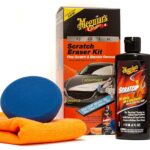Ford owners, especially those with models from the 2010s onwards, might be familiar with a peculiar and irritating issue: swollen lug nuts. While lug nuts are meant to securely fasten your wheels, Ford’s design choice has led to headaches for many. Instead of using solid, one-piece lug nuts, Ford opted for a two-piece design featuring a steel core capped with aluminum. This design, unfortunately, is prone to swelling and delamination, becoming a significant nuisance when you need to remove a wheel.
The core issue lies in the aluminum cap. It’s susceptible to corrosion and swelling, particularly when exposed to heat and moisture. This swelling means your standard lug wrench might no longer fit, or worse, the lug nut can become so tightly fused that removal becomes an extreme challenge. Imagine facing a flat tire only to discover your lug wrench is useless, and you’re stuck needing specialized tools or professional help.
Why Ford Lug Nuts Swell and Delaminate
The problem boils down to the materials and design. The aluminum cap over the steel core is the weak point. When these dissimilar metals are exposed to the elements, particularly road salt and moisture, galvanic corrosion can occur. This corrosion, combined with the heat generated from braking and general driving, causes the aluminum cap to expand and swell. Over time, this swelling can lead to the cap delaminating or separating from the steel core, further exacerbating removal problems. The trapped moisture between the cap and core also accelerates corrosion.
This design flaw isn’t just an inconvenience; it can lead to unexpected costs and roadside emergencies. Even roadside assistance services like AAA often struggle to remove these swollen lug nuts, requiring vehicle owners to be towed to a repair shop.
Models Affected by Ford Swollen Lug Nuts
This lug nut issue is prevalent in a range of Ford vehicles, particularly those from the post-2010 era. You’ll commonly find these two-piece lug nuts on models such as:
- Ford Fusion
- Ford Escape
- Ford Flex
- Ford Focus
- Ford F-150
- Ford F-350
Interestingly, Ford F-250 owners seem to have been spared from this particular design flaw.
The Swollen Lug Nut Class-Action Lawsuit
The frustration with Ford’s swollen lug nuts reached a point where a class-action lawsuit was filed in August 2017. The lawsuit accused Ford of using a cheaper, flawed design to cut costs, arguing that solid stainless steel lug nuts would have prevented the issue. Plaintiffs, represented by Hagens Berman, contended that Ford was aware of the problem but failed to address it adequately and refused warranty claims related to swollen lug nuts.
The lawsuit also challenged Ford’s “Ford Tough” marketing slogan, suggesting it was misleading given this known weakness. Ford dismissed this as mere advertising “puffery.”
Unexpected Costs and Dismissal of the Lawsuit
Owners faced not only the frustration of stuck lug nuts but also unexpected expenses. Repair shops typically recommend replacing all swollen lug nuts, and with each nut costing around $8, and five per wheel, the replacement costs can quickly add up, not to mention labor charges. One plaintiff in the lawsuit reported spending over $58 to replace lug nuts on just one wheel.
Despite numerous complaints and clear evidence of the issue, Ford remained largely unsympathetic. The company argued that lug nuts are not expected to last forever and warranties shouldn’t cover wear and tear to this extent. However, owners argued that lug nuts becoming impossible to remove after relatively short periods, even under warranty, was unacceptable.
Ultimately, in January 2019, a judge dismissed the class-action lawsuit. A key reason for the dismissal was that the plaintiffs failed to demonstrate that they had presented their vehicles to Ford for warranty claims within the warranty period. The judge also stated that while online complaints existed, they didn’t legally prove Ford’s prior knowledge or admission of a defect.
Dealing with Ford Swollen Lug Nuts: Prevention and Solutions
While the lawsuit didn’t succeed, the problem of swollen lug nuts persists for Ford owners. Here’s what you can do:
- Regular Inspection: Periodically check your lug nuts for signs of swelling or corrosion.
- Proper Socket: Keep both standard and slightly larger sockets (like 19.5mm or 20mm) in your vehicle. Swollen lug nuts often require a slightly larger socket than the standard 19mm.
- Penetrating Oil: If you encounter a stuck lug nut, apply penetrating oil and let it sit before attempting removal.
- Replacement: Consider replacing the two-piece lug nuts with solid, one-piece lug nuts. This is a permanent solution to avoid future swelling issues. Stainless steel or high-quality chrome vanadium lug nuts are good alternatives.
- Professional Help: If you’re unable to remove a swollen lug nut yourself, don’t hesitate to seek professional help from a tire shop or mechanic.
Ford swollen lug nuts are a known issue that can cause significant frustration and expense. Being proactive with inspection and considering replacement with solid lug nuts can save you from potential roadside headaches and costly repairs.
